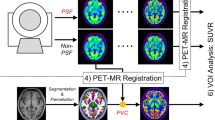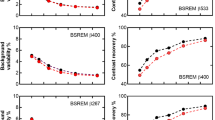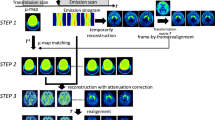Abstract
The ordered subset expectation maximization with a point spread function (OSEM-PSF) was developed to improve the spatial resolution of reconstructed positron emission tomography (PET) images and has been reported to improve the contrast of hot spots in PET studies for oncology. However, in neuroreceptor imaging, the regional radioactivity concentration changes dynamically during the scan, and the effects of the PSF may differ among various radioligands or quantification methods. In this study, we investigated the effects of the PSF on quantification in PET studies with [11C]FLB 457 of dopamine D2 receptors, using both phantom and human data acquired by the Siemens Biograph 16 imaging platform. In the phantom studies, we evaluated the hot contrast recovery coefficient (HCRC) for variously sized hot spheres and the linearity between the measured and true radioactivities in OSEM-PSF images. Next, in the human studies with [11C]FLB 457, radioactivity concentrations and binding potentials for the cerebral cortex and thalamus were compared between images reconstructed with and without PSF. In the phantom studies, the OSEM-PSF images showed a better HCRC compared to images without PSF, and they showed a good linear correlation with true radioactivity. In the human studies, the radioactivity concentration increased especially in small regions with high accumulation of [11C]FLB 457 when the PSF was included. However, little difference in the binding potentials was observed for the target regions between both types of reconstructed images. In conclusion, PSF-based reconstruction reduced the spill-over phenomena in small hot regions; however, it caused no increase in the binding potentials in the [11C]FLB 457 studies.








Similar content being viewed by others
References
Lasnon C, Hicks RJ, Beauregard JM, Milner A, Paciencia M, Guizard AV, et al. Impact of point spread function reconstruction on thoracic lymph node staging with 18F-FDG PET/CT in non-small cell lung cancer. Clin Nucl Med. 2012;37:971–6.
Bellevre D, Fournier CB, Switsers O, Dugué AE, Levy C, Allouache D, et al. Staging the axilla in breast cancer patients with 18F-FDG PET: how small are the metastases that we can detect with new generation clinical PET systems? Eur J Nucl Med Mol Imaging. 2014;41:1103–12.
Rapisarda E, Bettinardi V, Thielemans K, Gilardi MC. Image-based point spread function implementation in a fully 3D OSEM reconstruction algorithm for PET. Phys Med Biol. 2010;55:4131–51.
Panin VY, Kehren F, Michel C, Casey M. Fully 3-D PET reconstruction with system matrix derived from point source measurements. IEEE Trans Med Imag. 2006;25:907–21.
Tong S, Alessio AM, Kinahan PE. Noise and signal properties in PSF-based fully 3D PET image reconstruction: an experimental evaluation. Phys Med Biol. 2010;55:1453–73.
Volkow ND, Fowler JS, Gatley SJ, Logan J, Wang GJ, Ding YS, et al. PET evaluation of the dopamine system of the human brain. J Nucl Med. 1996;37:1242–56.
Wagner HN Jr, Burns HD, Dannals RF, Wong DF, Langstrom B, Duelfer T, et al. Imaging dopamine receptors in the human brain by positron tomography. Science. 1983;221:1264–6.
Wong DF, Gjedde A, Wagner HN Jr. Quantification of neuroreceptors in the living human brain. I. Irreversible binding of ligands. J Cereb Blood Flow Metab. 1986;6:137–46.
Farde L, Eriksson L, Blomquist G, Halldin C. Kinetic analysis of central [11C]raclopride binding to D2-dopamine receptors studied by PET–a comparison to the equilibrium analysis. J Cereb Blood Flow Metab. 1989;9:696–708.
Varrone A, Sjöholm N, Eriksson L, Gulyás B, Halldin C, Farde L. Advancement in PET quantification using 3D-OP-OSEM point spread function reconstruction with the HRRT. Eur J Nucl Med Mol Imaging. 2009;36:1639–50.
Halldin C, Farde L, Hogberg T, Mohell N, Hall H, Suhara T, et al. Carbon-11-FLB 457: a radioligand for extrastriatal D2 dopamine receptors. J Nucl Med. 1995;36:1275–81.
National Electrical Manufacturers Association. NEMA Standards Publication NU 2-2001: Performance Measurements of Positron Emission Tomographs. National Electrical Manufacturers Association. 2001.
Lammertsma AA, Hume SP. Simplified reference tissue model for PET receptor studies. Neuroimage. 1996;4:153–8.
Olsson H, Halldin C, Swahn CG, Farde L. Quantification of [11C] FLB 457 binding to extrastriatal dopamine receptors in the human brain. J Cereb Blood Flow Metab. 1999;19:1164–73.
Sureau FC, Reader AJ, Comtat C, Leroy C, Ribeiro MJ, Buvat I, et al. Impact of image-space resolution modeling for studies with the high-resolution research tomograph. J Nucl Med. 2008;49:1000–8.
Zeng GL. Gibbs artifact reduction by nonnegativity constraint. J Nucl Med Tech. 2011;39:213–9.
Nuyts J. Unconstrained image reconstruction with resolution modelling does not have a unique solution. EJNMMI Physics. 2014;1:98.
Nakamura A, Tanizaki Y, Takeuchi M, Ito S, Sano Y, Sato M, et al. Impact of point spread function correction in standardized uptake value quantification for positron emission tomography images: a study based on phantom experiments and clinical images. Nihon Hoshasen Gijyutsu Gakkai Zasshi. 2014;70:542–8.
Belanger MJ, Mann JJ, Parsey RV. OS-EM and FBP reconstructions at low count rates: effect on 3D PET studies of [11C] WAY-100635. Neuroimage. 2004;21:244–50.
Akamatsu G, Ishikawa K, Mitsumoto K, Taniguchi T, Ohya N, Baba S, et al. Improvement in PET/CT image quality with a combination of point-spread function and time-of-flight in relation to reconstruction parameters. J Nucl Med. 2012;53:1716–22.
Acknowledgments
We thank the staff of the clinical research support section, the clinical neuroimaging team, and the radiopharmaceutical production team at the Molecular Imaging Center, National Institute of Radiological Sciences, for their assistance in conducting the PET studies. This study was supported by the National Institute of Radiological Sciences in Japan as an IAEA Collaborating Center.
Author information
Authors and Affiliations
Corresponding author
Ethics declarations
Conflict of interest
The authors declare that they have no conflict of interest.
About this article
Cite this article
Thongpraparn, T., Ikoma, Y., Shiraishi, T. et al. Effects of point spread function-based image reconstruction on neuroreceptor binding in positron emission tomography study with [11C]FLB 457. Radiol Phys Technol 9, 127–137 (2016). https://doi.org/10.1007/s12194-015-0343-0
Received:
Revised:
Accepted:
Published:
Issue Date:
DOI: https://doi.org/10.1007/s12194-015-0343-0




